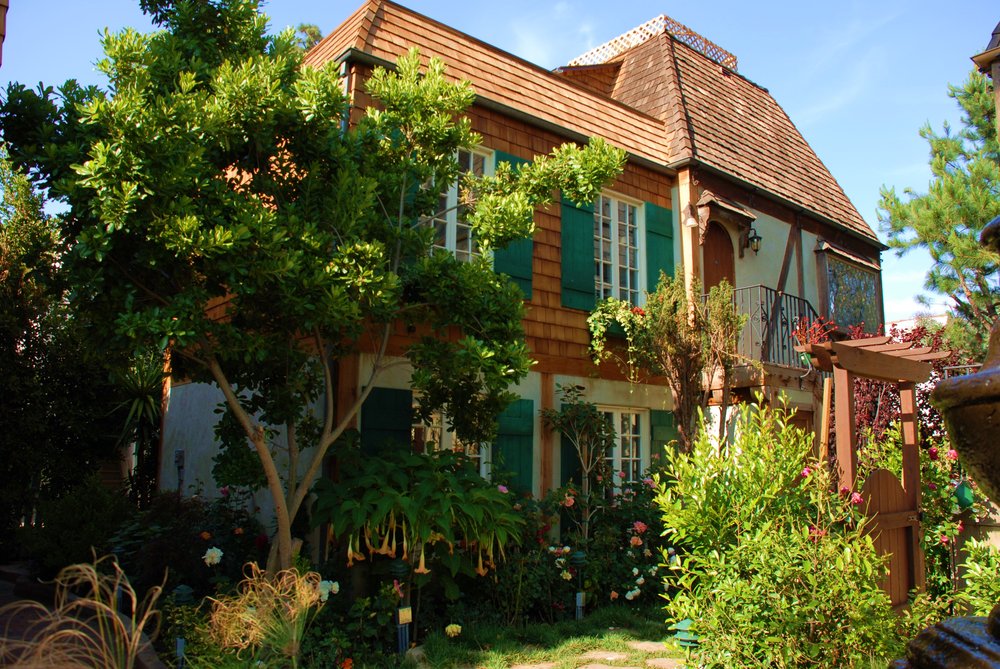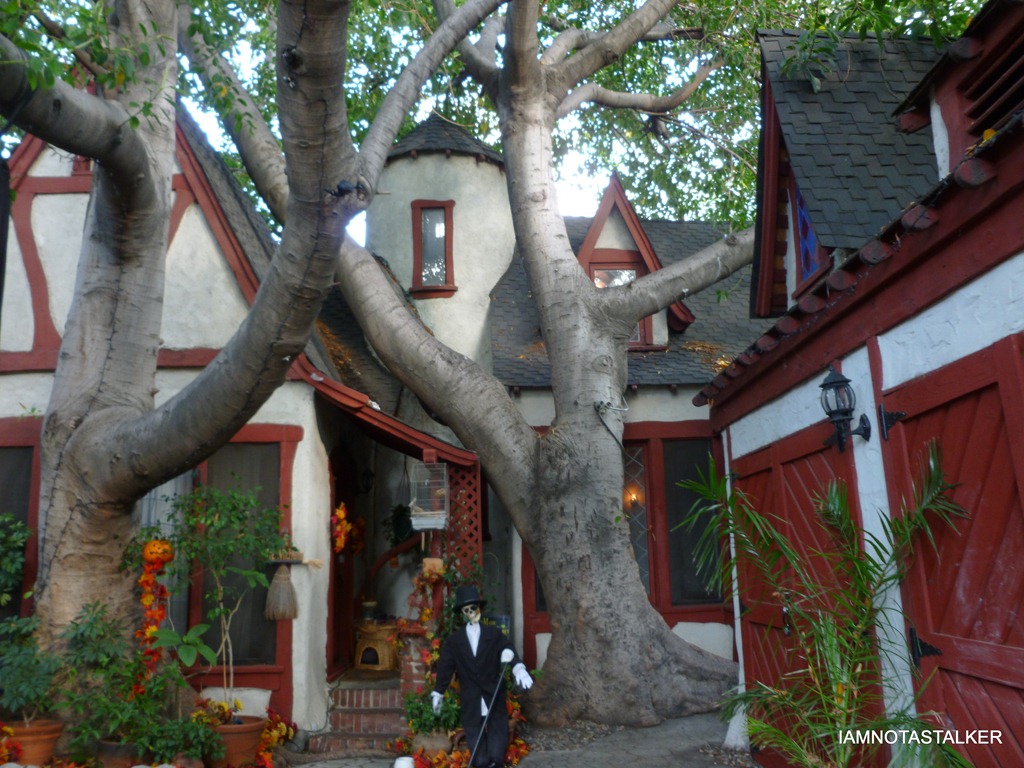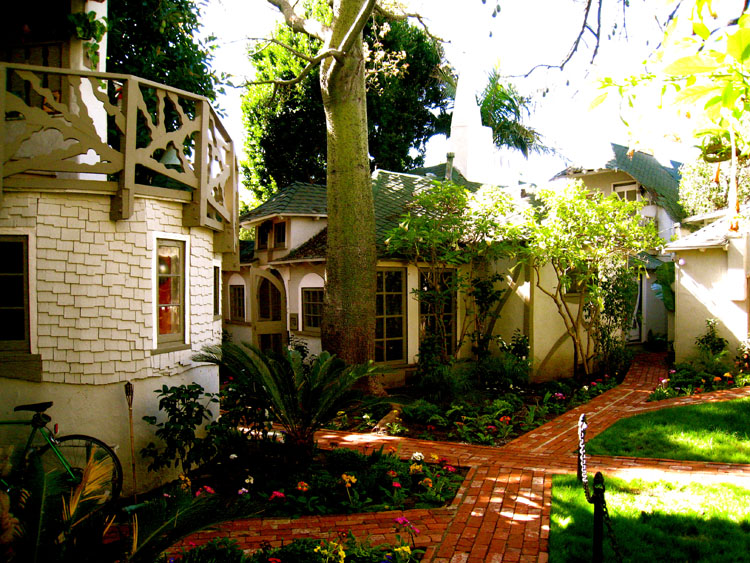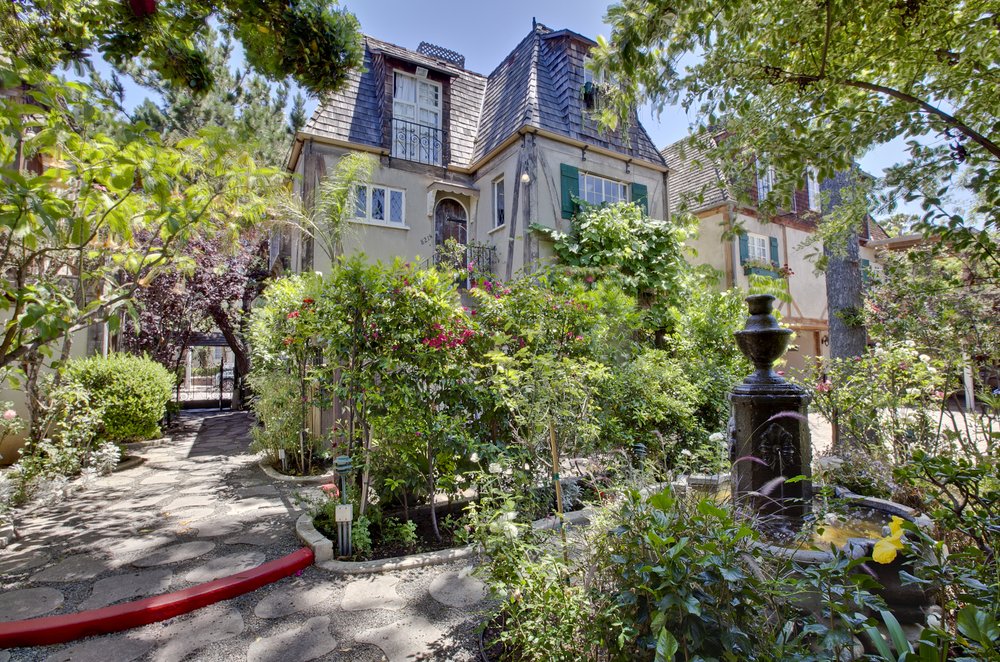
California’s population boom of the 1920s saw an influx of more than two million new residents attracted by bustling businesses in oil, agriculture and entertainment. More than half of those transplants settled in the Los Angeles area, doubling the number of people living here in just a few years.
The new arrivals in turn fueled a boom in housing construction, primarily for single-family homes that they preferred. Suburbs sprouted in vast open tracts of land on the fringes, leaving most newbies to endure long commutes to and from work on an ever-expanding electric streetcar system.
Charlie Chaplin had a different idea. After building Chaplin Studios in a Hollywood orange grove on North La Brea Avenue in 1917, he decided that motion picture production would be more efficient if actors and crews lived nearby.
With very few apartments or hotels in the neighborhood to house them, he began a building boom of his own that mirrored the growth of the movie industry specifically and Los Angeles overall.
Chaplin constructed three sets of courtyard-style cottages in the unincorporated community of West Hollywood from 1923 to 1931. Each cluster featured period revival styles of Tudor architecture that reminded him of his native England. Leading show business stars of the era lived in them at various times in their careers, along with studio crew members.
Something worked, because Chaplin proceeded to make some of his most memorable and successful movies including “The Gold Rush” (1925), “City Lights” (1931), “Modern Times” (1936) and “The Great Dictator” (1939).
Two cottage clusters, in fact, have been designated as cultural resources – or city landmarks – by West Hollywood because they “represent one of the best and broadest ranging collections of historic multi-family housing in the region,” the city’s website notes.
“These cottage clusters provided an intimate, low-density housing alternative to members of the motion picture industry, in close proximity to major studios,” according to the city’s website. Today they still serve as home to many in the entertainment business or creative crafts.
They are: Normandie Towers, 7219 Hampton Ave.; The Charlie hotel, 819 N. Sweetzer Ave., and Formosa Cottages (or Chaplin Court), 1328 N. Formosa Ave. They are not accessible to the general public. Taken as a group, they represent several more lasting marks Chaplin left on the city, in addition to his contributions as a comic genius, a pivotal star in the early days of Hollywood, and one of the greatest filmmakers in the history of American cinema.
Beginning with the year they were built, here’s a profile of each of Chaplin’s clusters of cottages.

1328 N. Formosa Ave.
Formosa Cottages (Also Chaplin Court or Chaplin Bungalows)
These were the first cluster of cottages Chaplin built to house actors and crews at this studio just two blocks away. Built in 1923, the group has four apartments altogether in three separate buildings. They have not been given historic preservation status by West Hollywood.
Their storybook, French chalet-style design is by noted architects Arthur and Nina Zwebell, who are responsible for some of Hollywood’s most famous courtyard apartments. Building permits list the couple as the actual builders, but Chaplin reportedly had them construct the units for his studio employees and those doing business there.
Chaplin lived in one of the units here, just as he did in each of the other two cottage clusters he built. These quaint apartments also were home to film luminaries like Douglas Fairbanks, who lived here in the 1920s when the movies “The Thief of Bagdad,” “The Black Pirate” and “The Iron Mask” were released, and Rudolph Valentino, who lived at these Chaplin bungalows in the 1920s when his movies “The Cobra,” “The Son of the Sheik” and “The Eagle” were released.
Other stars like Judy Garland and John Barrymore who reportedly lived there but that could not be confirmed.

7219 Hampton Ave.
Normandie Towers – Historic Landmark
The Normandie Towers website says these cottages were built in 1924 by the same crews that built sets at Chaplin’s studio. The buildings are located one block from the former Pickford-Fairbanks Studios (now The Lot).
They were designated as a cultural resource by the city in 2008. There are five buildings with a total of 25 apartments. The complex, constructed in the Tudor Revival architectural style, is an example of “theatrically” styled cottage groupings constructed to appeal to individuals involved in the motion picture industry.
Roscoe “Fatty” Arbuckle stayed here often during the 1920s, a time when movies he directed including “Curses,” “The Iron Mule” and “Special Delivery” were released. Other celebrity residents, according to the cottages’ website, were Theda Bara, Buster Keaton, Edna Purchase, Douglas Fairbanks, Lillian Gish, Norma Shearer, G.M. Anderson (Bronco Billy), Pola Negri, Jean Harlow, Adolf Menjou, John Rand, Wallace Beery and Rudolph Valentino.
During the 1950s, Paul Williams composed music from the very smallest studio very early in his career when his albums “A Little Bit of Love” and “Ordinary Fool” were released. Actor Anthony Zerbe, who played the leper in “Papillon,” studied for his role in one of these apartments. Director John Schlesinger filmed scenes from “Day of the Locust” in the center courtyard, according to the cottages’ website.

819 N. Sweetzer Ave.
The Charlie Hotel – Historic Landmark
These hideaway cottages – like all of those Chaplin built – are said to have been home to stars including Marilyn Monroe, Gloria Swanson and Marlene Dietrich, among many others. Each of the 13 cottages is named after a celebrity who once lived there (“Betty,” “Clark,” “Gregory,” etc.). The cluster of cottages has been designated as a cultural resource or city landmark by West Hollywood.
The 27,000 square-foot property originally was known as LaBrea Farm. Like much of West Hollywood then, it was a farm with only a farmhouse and a stable, both of which were razed. An early owner of the site was the mother of actress-screenwriter Ruth Gordon, who lived in the farmhouse with her screenwriter husband, Garson Kanin. A cottage is named for Ruth. Chaplin and Rudolph Valentino are said to have kept horses in the stable.
The Los Angeles Times reported that Chaplin bought the site in 1924 and then developed the English-style bungalows in 1931. Chaplin, of course, also had a home in Beverly Hills and officially used one of the cottages as a writing studio, while press reports said his bungalow actually was a pied-a-terre.
Current owner Menachem Treivush extensively renovated the cottages in the early 2000s and reopened for business in 2008 to glowing reviews by news media. “GQ” magazine named The Charlie its “coolest new hotel” for 2010. The same year, the Los Angeles Times noted, “The Charlie, with its fairy-tale shingled cottages, leaded glass windows and unmanicured garden, is very English,” noting that one guest called it “a country estate in the middle of the city.”

Is their a fourth court? There is a 1937 photo showing the sign above the entrance to the Gingerbread Court in Venice Beach, CA, as “Charlie Chaplin’s Gingerbread Court.” Relators claim he built it in 1922 and used it as a “summer home.” The Blu House next door was for sale at the same time. Perhaps that was his summer home and the several separate units of the court were used like his other courts.
In the late 80’s and early 90’s this complex was very much alive with odd tenants and sordid ongoings. Fun times.
Loved your article. I lived at the Charlie the year it opened in 2008 for a 3 month period. It was a lovely experience! The owner Menachem Treivush managed to rejuvenate the spirit of Charlie Chaplain in the only way a man of great heart could have. Now deceased, his family should find comfort in Menachem’s vision, enthusiasm and great love of The Charlie.
Charlie Chaplin also owned a cottage in Waterville Co. Kerry Ireland – which is as quirky as any he owned in California… I walk by it daily … and would just love to live in it! … if only I had the mullah! Angela
hey E-V, if that’s your real name, you have no idea what i do or do not do, to contribute to our community.
appreciate the compliment about my snark, you should get a whiff of what posts they won’t publish on this site. pretty funny stuff.
as for your suggestion about an application, i’ll let you get the ball rolling and i’ll consider filing an amicus brief.
EverVigilant, pull your head out of the ground and actually see what is going on in West Hollywood. Everything is being demolished and nobody can do anything about it.
Tom Smart & Luca d: Do you realize with a little more effort than publishing snarky, not so smart comments you both could actually become advocates for the listing of the Chaplin Formosa Cottages? Submitting an application is not a really big challenge and you might make a visible contribution to the public good. That could make you feel like part of the solution rather than the problem.
Many thanks Bob for the special article, it’s a pleasure to see our history illuminated.
I’m sorry but did I miss the demolishion date??? Surely the developer cronies on the council are already planning to bulldoze this bit of charm for a high rise, celebrity club, or another automated toy garage, no?
thanks, Bob Bishop, this is a great series!
careful, the city leaders may drive their developer friends by these jewels and persuade them to tear them down and build stacked boxes with tasteful wood accents.